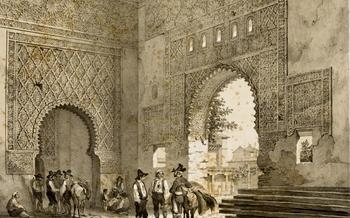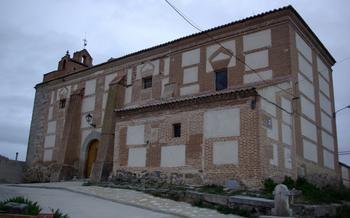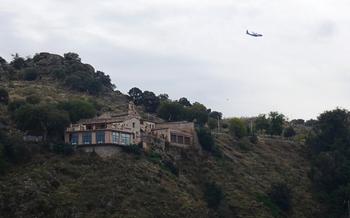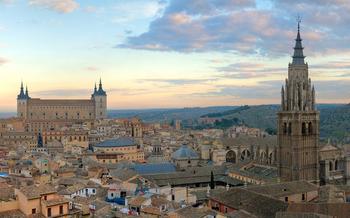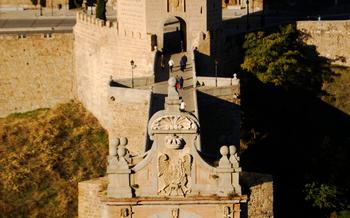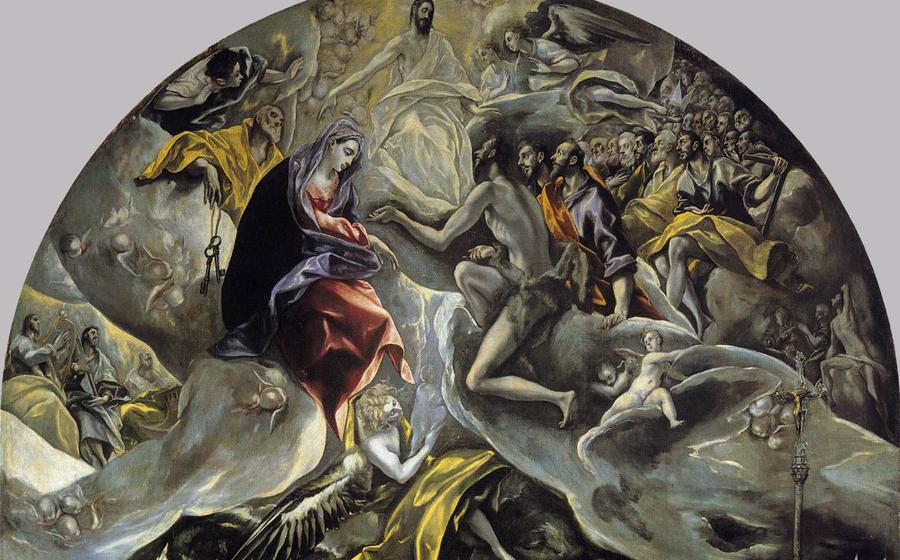
The Church of Santo Tomé (El Greco's The Burial of the Count of Orgaz)
- The Church of Santo Tomé: A Timeless Treasure
- History and Significance
- Architectural Features and Artistic Value
- Location and accessibility
- Interesting Facts and Anecdotes
- El Greco's Masterpiece
- Visiting the Church: Practical Information
- Other Works of Art
- Exploring Toledo's Old Town
- The City of Three Cultures
- The Alcázar of Toledo
- Toledo Cathedral: A Gothic Masterpiece
- The Museo del Greco: Exploring the Master's Legacy
- The Santo Tomé Square: A Lively Gathering Place
- Toledo's Culinary Delights
- Toledo's Festivals and Events
- Insider Tips:
The Church of Santo Tomé: A Timeless Treasure
History and Significance
Standing tall and proud in the heart of Toledo, Spain, the Church of Santo Tomé is a magnificent testament to the city's rich history and artistic heritage. Constructed in the 14th century, the church has undergone several renovations and expansions over the centuries, resulting in a harmonious blend of architectural styles, from Gothic to Renaissance. It holds a prominent place in Spanish history, having witnessed significant religious and cultural events throughout the ages.
Architectural Features and Artistic Value
The Church of Santo Tomé boasts an impressive array of architectural features that captivate visitors. Its exterior showcases intricate stone carvings, delicate tracery, and soaring buttresses, reflecting the Gothic style prevalent at the time of its construction. The interior, adorned with ornate altars, stained glass windows, and vaulted ceilings, is a testament to the artistic prowess of Spanish craftsmen. It is here that visitors can marvel at the church's most prized possession – El Greco's masterpiece, The Burial of the Count of Orgaz.
Location and accessibility
Situated in the heart of Toledo's historic center, the Church of Santo Tomé is easily accessible on foot or by public transportation. It is just a short walk from the city's main square, the Plaza de Zocodover, making it a convenient stop for visitors exploring Toledo's many attractions.
Interesting Facts and Anecdotes
The Church of Santo Tomé is home to several fascinating stories and legends. One intriguing tale revolves around the burial of the Count of Orgaz, whose tomb lies beneath the church's altar. According to legend, the Count was a pious man who dedicated his life to charity and good deeds. Upon his death, Saint Augustine and Saint Stephen miraculously descended from heaven to assist in his burial, an event depicted in El Greco's masterpiece.
El Greco's Masterpiece
The Church of Santo Tomé is home to one of the most celebrated masterpieces of the Spanish Renaissance, "The Burial of the Count of Orgaz" by the renowned artist El Greco. Created in 1586-1588, the painting depicts the legendary burial of Count Gonzalo Ruiz de Toledo, a local nobleman.
Symbolism and Composition: The painting is a captivating blend of religious symbolism, earthly realism, and El Greco's unique style. It's divided into two distinct sections: the heavenly realm above and the earthly realm below. In the upper section, Christ, surrounded by saints and angels, welcomes the soul of the Count into heaven. The lower section shows the Count's burial, attended by a somber procession of mourners, including El Greco himself, depicted as one of the pallbearers.
The Story of the Count of Orgaz: The painting is based on a local legend about the Count of Orgaz, who was said to have been miraculously assisted by Saint Stephen and Saint Augustine during his burial. El Greco's depiction captures this moment of divine intervention, with the two saints gently lowering the Count's body into the grave.
El Greco's Influence: "The Burial of the Count of Orgaz" showcases El Greco's distinctive style, characterized by elongated figures, vibrant colors, and dramatic lighting. His innovative approach to perspective and composition challenged traditional Renaissance norms and had a profound impact on the development of Spanish art.
Visiting the Church: Practical Information
The Church of Santo Tomé welcomes visitors with open arms, inviting them to immerse themselves in the artistic and spiritual wonders it holds. To ensure a smooth and enriching visit, here are some practical details to keep in mind:
-
Opening Hours: The church is open to the public from Monday to Saturday, typically from 10 am to 1 pm and from 3 pm to 6 pm. On Sundays, it remains open from 10 am to 1 pm. Plan your visit accordingly to avoid any inconvenience.
-
Admission Fees: Admission to the church is subject to a modest entrance fee, which helps in the upkeep and preservation of this historical treasure. The standard fee is usually around 3 euros, but concessions may be available for students, seniors, or groups.
-
Guided Tours and Audio Guides: Enhance your visit with a guided tour, led by knowledgeable experts who will unravel the history, symbolism, and significance of El Greco's masterpiece and other artworks in the church. Audio guides are also available for rent, providing a self-guided tour at your own pace and convenience.
-
Photography and Videography Policies: While photography is generally permitted within the church, it is essential to be respectful of the sacred nature of the space. Flash photography and tripods are usually not allowed to preserve the integrity of the artworks and the overall ambiance. Videography may require special permission or prior arrangements.
-
Accessibility for Visitors with Disabilities: The Church of Santo Tomé strives to ensure accessibility for all visitors, regardless of their physical abilities. Wheelchair ramps and elevators are available to facilitate movement within the church, allowing everyone to marvel at its beauty.
Other Works of Art
Beyond El Greco's masterpiece, the Church of Santo Tomé houses a treasure trove of other notable artworks. Among them, visitors can admire the captivating paintings of Juan de Borgoña, a contemporary of El Greco. His works, such as "The Annunciation" and "The Visitation," showcase his mastery of color and composition, adding to the church's artistic allure.
The church also boasts impressive sculptures, including the intricately carved alabaster altarpiece by the Renaissance sculptor Alonso Berruguete. With its intricate details and lifelike figures, the altarpiece depicts scenes from the life of Christ and adds a touch of grandeur to the church's interior.
Furthermore, visitors can find artifacts of historical and cultural significance within the church. The sacristy, for example, displays a collection of liturgical objects, including chalices, monstrances, and vestments, offering a glimpse into the church's rich religious heritage.
These diverse artworks complement El Greco's masterpiece, creating a harmonious ensemble that reflects the artistic and cultural significance of the Church of Santo Tomé. They provide a deeper understanding of the artistic landscape of Toledo during the Renaissance period and enhance the overall experience for visitors who come to admire El Greco's iconic painting.
Exploring Toledo's Old Town
Toledo's Old Town, a UNESCO World Heritage Site, is a captivating maze of narrow cobblestone streets, historic buildings, and hidden courtyards. Take a leisurely stroll through the ancient Jewish Quarter (Judería), with its well-preserved synagogues and evocative atmosphere. Visit the iconic Zocodover Square, the heart of the city, and admire the surrounding Renaissance architecture. Don't miss the stunning views from the Mirador del Valle viewpoint, where you can capture panoramic shots of Toledo's skyline.
Explore the labyrinthine streets, where you'll stumble upon charming cafes, artisanal boutiques, and traditional restaurants. Indulge in local delicacies like marzipan, Manchego cheese, and migas, which reflect Toledo's rich culinary heritage. Immerse yourself in the city's vibrant atmosphere, where history and modernity seamlessly blend.
Toledo offers a plethora of cultural experiences. Visit the Museo del Greco to delve into the life and works of the renowned artist, El Greco, who left an indelible mark on the city. Participate in traditional crafts workshops, such as ceramic painting or sword-making, to learn about Toledo's artisanal legacy. Experience the city's vibrant nightlife, with a variety of bars and clubs catering to diverse tastes.
The best time to visit Toledo is during the shoulder seasons (spring and autumn) when the weather is pleasant and the crowds are smaller. However, the city's unique charm shines through all year round, offering a memorable experience regardless of the season.
The City of Three Cultures
Toledo, a city steeped in history, proudly bears the title of "The City of Three Cultures." This moniker stems from its unique blend of Christian, Muslim, and Jewish heritage, which has left an indelible mark on its architecture, culture, and traditions.
During the Middle Ages, Toledo was a melting pot of different religions and cultures. Christians, Muslims, and Jews lived side by side, creating a vibrant and cosmopolitan society. This coexistence led to a rich exchange of ideas, knowledge, and artistic influences.
The architectural legacy of this era is evident in Toledo's diverse landmarks. The Gothic cathedral, with its soaring spires, stands as a testament to Christian power. The Alcázar, a formidable fortress, reflects the city's military significance. And the well-preserved Jewish quarter, with its narrow streets and synagogues, speaks to the enduring presence of the Jewish community.
Toledo's cultural heritage is equally diverse. Its cuisine, music, and festivals all bear the imprint of the three cultures that shaped its history. Traditional dishes like marzipan and Manchego cheese showcase the culinary influences of each community. The city's music is a blend of Christian, Muslim, and Jewish melodies, creating a unique and harmonious sound.
The legacy of tolerance and diversity in Toledo is a testament to the city's ability to embrace different cultures and religions. This rich heritage continues to shape the identity of Toledo, making it a city that is both fascinating and welcoming.
The Alcázar of Toledo
Standing tall on a hill overlooking the city, the Alcázar of Toledo is a sight to behold. This imposing fortress, once a royal palace, is a testament to Toledo's rich history and strategic importance. Its commanding position allowed it to control the Tajo River and the surrounding countryside, making it a vital defensive point.
The Alcázar has undergone numerous transformations over the centuries, reflecting the changing needs and tastes of its occupants. The Romans built the original fortification, which served as a military outpost. Later, the Visigoths and Arabs expanded and strengthened the structure. In the 16th century, Emperor Charles V ordered a grand renovation, resulting in the magnificent Renaissance palace we see today.
The Alcázar's architectural styles blend harmoniously, creating a unique and visually stunning edifice. Its imposing walls, towers, and turrets evoke a sense of strength and grandeur. Inside, visitors can explore opulent halls, courtyards, and chambers adorned with intricate carvings, tapestries, and works of art.
The Alcázar's history is as fascinating as its architecture. It served as a royal residence for centuries, hosting monarchs like Alfonso VI, Alfonso X, and Charles V. It also played a crucial role in the Spanish Civil War, enduring a brutal siege that left it in ruins. Painstakingly restored after the war, the Alcázar now houses the Army Museum, showcasing Spain's military history and heritage.
Ascending to the Alcázar's terraces rewards visitors with breathtaking panoramic views of Toledo. The city's iconic landmarks, including the cathedral, the Church of Santo Tomé, and the Tajo River, unfold before your eyes, creating a picture-perfect moment.
Whether you're a history buff, an architecture enthusiast, or simply in search of stunning vistas, the Alcázar of Toledo is an unmissable attraction. Its rich past, architectural grandeur, and panoramic views make it a highlight of any visit to this enchanting city.
Toledo Cathedral: A Gothic Masterpiece
Toledo Cathedral, a magnificent symbol of Gothic architecture and religious devotion, stands as a testament to the city's rich history and spiritual heritage. Its imposing structure dominates the skyline, inviting visitors to explore its architectural wonders and immerse themselves in its sacred atmosphere.
The cathedral's construction began in the 13th century and spanned several centuries, resulting in an awe-inspiring blend of architectural styles. The exterior boasts intricate carvings, majestic buttresses, and a stunning bell tower that reaches towards the heavens. Inside, visitors are greeted by soaring vaults, delicate stained-glass windows that cast a kaleidoscope of colors, and an array of captivating altars and chapels.
Among the cathedral's most notable features is the Capilla Mayor, or Main Chapel, which houses the elaborate High Altar. This masterpiece of Gothic art is adorned with intricate carvings, sculptures, and paintings, depicting scenes from the life of Christ and the Virgin Mary. The cloister, with its serene courtyard and delicate arches, offers a tranquil oasis amidst the cathedral's grandeur.
Toledo Cathedral holds immense historical and religious significance. It served as the seat of the Primate of Spain, the highest-ranking bishop in the country, and played a crucial role in the Catholic Church's governance. Throughout history, the cathedral has witnessed countless religious ceremonies, royal coronations, and important events that shaped the course of Spanish history.
To fully appreciate the grandeur of Toledo Cathedral, visitors can embark on a guided tour or explore its vast interior at their own pace. The cathedral also offers a variety of educational programs, concerts, and exhibitions that delve into its history, art, and cultural significance. A visit to Toledo Cathedral is an unforgettable experience that leaves visitors in awe of its architectural beauty and spiritual grandeur.
The Museo del Greco: Exploring the Master's Legacy
The Museo del Greco, located in the heart of Toledo's historic center, is a must-visit destination for art enthusiasts and those seeking a deeper understanding of El Greco's life and work. Established in 1911, the museum is housed in a 16th-century building that once belonged to the painter himself.
El Greco's Masterpieces Under One Roof: The museum boasts an extensive collection of El Greco's paintings, spanning different periods of his career. Visitors can admire masterpieces such as "The Agony in the Garden," "The Assumption of the Virgin," and "The Baptism of Christ." These works showcase El Greco's unique style, characterized by elongated figures, vibrant colors, and dramatic lighting.
Unveiling the Artist's Creative Process: In addition to paintings, the museum exhibits El Greco's drawings, sketches, and personal belongings. These items provide valuable insights into the artist's creative process and working methods. Visitors can also learn about El Greco's life in Toledo, his relationship with his patrons, and the influence of his Byzantine and Italian heritage on his art.
A Journey Through El Greco's World: The Museo del Greco offers a comprehensive exploration of El Greco's artistic journey. Through its collection, the museum sheds light on the painter's technical prowess, his innovative approach to composition and perspective, and his deep religious devotion. Visitors leave the museum with a profound appreciation for El Greco's genius and his enduring impact on the history of art.
The Santo Tomé Square: A Lively Gathering Place
The Santo Tomé Square, or Plaza de Santo Tomé, is a bustling square located just outside the Church of Santo Tomé. It holds historical significance as the site where the church once stood before its reconstruction in the 14th century. The square is surrounded by historical buildings, including the 16th-century Palacio de Lorenzana, which now houses the Museo de los Concilios y de la Cultura Visigoda.
The square is a lively gathering place for locals and tourists alike, with its array of cafes, restaurants, and shops. Visitors can enjoy a leisurely meal or a refreshing drink while basking in the square's vibrant atmosphere. The square also hosts various events and performances throughout the year, adding to its charm and appeal.
One notable feature of the Santo Tomé Square is its fountain, which depicts a young woman holding a jug of water. The fountain, known as the Fuente de la Mujer del Cántaro, is a popular meeting point and a symbol of the square's lively spirit.
Whether you're looking to soak up the historical ambiance, enjoy a bite to eat, or simply people-watch, the Santo Tomé Square is a must-visit destination in Toledo. Its vibrant atmosphere and rich history make it a perfect place to relax and immerse yourself in the city's unique charm.
Toledo's Culinary Delights
Toledo's rich history and cultural tapestry are reflected in its diverse cuisine, a fusion of flavors influenced by Christian, Muslim, and Jewish traditions. Visitors can savor traditional dishes and local specialties that showcase the city's unique culinary heritage.
Must-try foods include marzipan, a sweet treat made from almonds, sugar, and egg whites, which originated in Toledo during the Middle Ages. Manchego cheese, a hard sheep's milk cheese produced in the nearby La Mancha region, is another local delicacy. Migas, a hearty dish made from fried breadcrumbs, garlic, and various meats, is a popular breakfast or lunch option.
Toledo's cuisine also boasts influences from its Jewish community. One notable dish is carcamusas, a stew made with chickpeas, pork, and spices. Another is alboronía, a vegetable stew with eggplant, zucchini, and tomatoes.
To experience Toledo's culinary delights, visitors can explore the city's many restaurants, cafés, and tapas bars. Local markets, such as the Mercado de San Agustín, offer a vibrant atmosphere and a chance to sample fresh produce and local specialties. Food tours are also available for those who want to delve deeper into Toledo's culinary scene and learn about its rich history.
Toledo's Festivals and Events
Toledo's vibrant cultural scene shines through its annual festivals and events, showcasing the city's rich heritage and traditions. The most notable celebration is Corpus Christi, a religious festival that takes place in May or June. During Corpus Christi, the streets of Toledo are adorned with colorful tapestries, flowers, and elaborate altars, creating a mesmerizing spectacle. Processions featuring costumed participants, religious icons, and traditional dances fill the city with joy and spirituality.
Another highlight is the Toledo Medieval Market, held annually in October. This unique event transports visitors back in time, with merchants dressed in medieval attire, craft demonstrations, and live performances. The market offers a glimpse into Toledo's past, with stalls selling traditional handicrafts, local delicacies, and souvenirs.
For music enthusiasts, the Toledo Classical Music Festival in July and August presents world-renowned orchestras and soloists performing in the city's historic churches and concert halls. The festival features a diverse program of classical music, from Baroque to contemporary compositions.
If you're visiting Toledo in September, don't miss the Fiesta de la Vendimia, a celebration of the grape harvest. This lively festival includes wine tastings, grape stomping competitions, traditional music and dance performances, and a parade showcasing the region's agricultural heritage.
To fully immerse yourself in Toledo's cultural festivities, plan your visit to coincide with one of these special events. The city comes alive during these celebrations, offering a unique opportunity to experience its vibrant atmosphere and rich traditions.
Insider Tips:
To delve into the heart of Toledo's allure, embrace the local spirit by venturing beyond the beaten path. Discover hidden gems like the Mezquita del Cristo de la Luz, a former mosque showcasing unique architecture. For breathtaking panoramas, climb the Torre de la Catedral to witness the city's tapestry of red roofs and ancient spires.
Art enthusiasts should explore the Museo de Santa Cruz, housing a trove of medieval and Renaissance masterpieces. Immerse yourself in the city's vibrant culinary scene by savoring traditional dishes at local restaurants. Don't miss the opportunity to taste the melt-in-your-mouth marzipan, a Toledo specialty.
For photography enthusiasts, capture the essence of Toledo's charm in the early morning or late evening, when the golden light casts a magical glow on its historic streets. Stroll along the scenic Paseo de Recaredo for unparalleled views of the Alcázar and the Tagus River.
Make the most of your visit by planning your trip to coincide with one of Toledo's many festivals or events. The Festival de Otoño, held in autumn, offers a diverse program of theater, music, and dance performances. The Corpus Christi procession is a spectacle of color and tradition, showcasing elaborate floats and religious iconography.
Remember, the best way to experience Toledo is to embrace its rich tapestry of history, culture, and art. Engage with locals, soak in the atmosphere, and let the city's magic captivate you.
